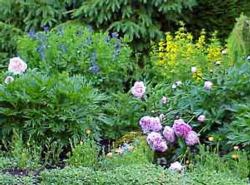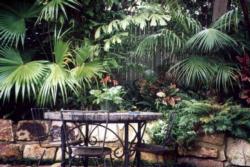The EH Industry in California
What is Environmental Horticulture?

The EH Industry can be divided into three components:
-
production of all stages and kinds of ornamental plants from seed to sod, and cuttings to cut flowers.
-
services and uses which include landscape design/architecture, installation and maintenance of turfgrass, woody plants, annuals and other plant materials, plus the retail sales of ornamentals and garden plants, and research and education in ornamental horticulture.
-
equipment and accessories that support the production and maintenance activities.
The EH industry is estimated to have a statewide economic activity well over $10 billion annually, with approximately 60% centered in Southern California. Services and uses account for slightly more than 50% of the total economic activity, production about 20%, and equipment and accessories about 30%.
The industry's components are inter-related and have direct interaction with end users who are the beneficaries and consumers of the EH industry's products and services. Their needs and interests dictate the type of products and services offered by the industry. Users include county and city parks and public works departments, golf courses, homeowners, and landscape contractors.
 There are many diverse clientele groups within EH in California, and there is typically little organization among them. Examples of clientele groups and their approximate memberships in Southern California are: Licensed landscape contractors (1,500), landscape architects (1,200), sod growers (4), arborists and city street tree managers (500+), water agencies (60+), several hundred each of wholesale landscape plant nurseries, bedding plant growers, cut flower growers, along with urban forestry agencies and groups, irrigation managers and engineers, and municipal parks, planning and public works departments.
There are many diverse clientele groups within EH in California, and there is typically little organization among them. Examples of clientele groups and their approximate memberships in Southern California are: Licensed landscape contractors (1,500), landscape architects (1,200), sod growers (4), arborists and city street tree managers (500+), water agencies (60+), several hundred each of wholesale landscape plant nurseries, bedding plant growers, cut flower growers, along with urban forestry agencies and groups, irrigation managers and engineers, and municipal parks, planning and public works departments.

UC Cooperative Extension's Program Activity in Environmental Horticulture Educational and applied research programs conducted by UC Cooperative Extension Advisors and Specialists generally focus on solving important problems facing the production and service components of California’s EH industry, with particular emphasis on developing resource-efficient production and management systems along with selection of appropriate plant material. Broad issues currently receiving attention across the state include:
-
water management and conservation, including water quantity and quality - plant water needs, woody plant stress physiology, use of reclaimed water on landscape plants and turfgrass, nursery production practices that maintain the quality of water resources.
-
plants’ impacts on environmental quality - both positive and negative.
-
plant selection and improvement - improved water and temperature stress tolerances, pest tolerance, improved horticultural qualities, and reduced defects of woody plant root systems.
Numerous other issues are receiving attention on a local or limited scale.
